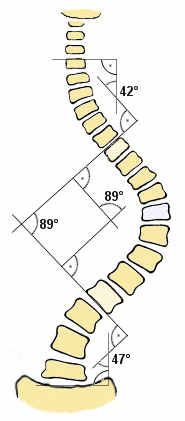 | ||
The Cobb angle, named after the American orthopedic surgeon John Robert Cobb (1903–1967), was originally used to measure coronal plane deformity on antero-posterior plane radiographs in the classification of scoliosis. It has subsequently been adapted to classify sagittal plane deformity, especially in the setting of traumatic thoracolumbar spine fractures.
In the setting of spine trauma and assessing sagittal plane deformity, the Cobb angle is defined as the angle formed between a line drawn parallel to the superior endplate of one vertebra above the fracture and a line drawn parallel to the inferior endplate of the vertebra one level below the fracture.
The Cobb angle is the preferred method of measuring post-traumatic kyphosis in a recent meta-analysis of traumatic spine fracture classifications.
Scoliosis cases with Cobb angles between 40 and 50 degrees at skeletal maturity progress at an average of 10 to 15 degrees during a normal lifetime. Cobb angles of more than 50 degrees at skeletal maturity progress at about 1 to 2 degrees per year.
